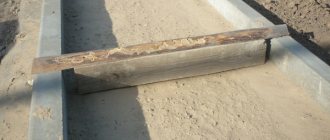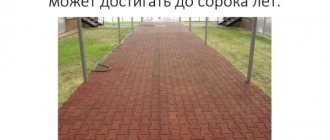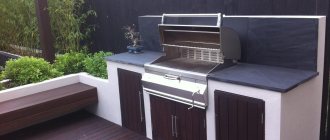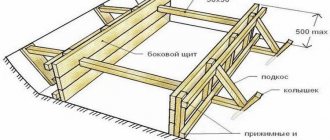Creating a unique design
Many craftsmen love and know how to make such coatings themselves. At the same time, you can play with color and shape.
By making your own tiles and laying them according to your own taste, you can personalize the design, make your yard bright and special, and decorate garden paths and streets.
Mold for paving slabs from COMBIUBIU (size 27*27*8 cm, 1 piece)
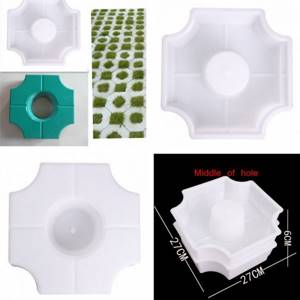
Price: from 412.69 rub. (check price and discount)
Seller's reliability: excellent!
Delivery within Russia: free!
Be sure to order on the Aliexpress website with free delivery throughout Russia.
Excellent product, super quality and packaging. I recommend the seller. I will only order tile molds from him.
Valya
The first shipment arrived damaged, we must pay tribute to the seller - he did not figure out who was to blame: the packaging or the mail and sent the product again, it arrived without damage. OUR RESPECT TO THE SELLER.
CmeTaHa
Everything is fine. According to the description, it matches, it came whole, but the seller saved a bubble, and the form was dirty, sends the goods dirty, not nice!!! That's why I give it 4.
your_problem
View on AliExpress:
Variety of coating types
Tiles are becoming more varied in shape and color every year. Thus, the following forms are well known:
- Brick – gives maximum strength to the coating
- Cobblestone stylish simplicity produced by vibration casting
- Rhombus is convenient because it looks good in any design.
- Square is another popular type of tile, rich in beautiful shapes and types. You can create interesting compositions.
- Clover - suitable for park paths, squares, and can withstand any bad weather.
- Wave is another type of durable tile that creates a mosaic effect.
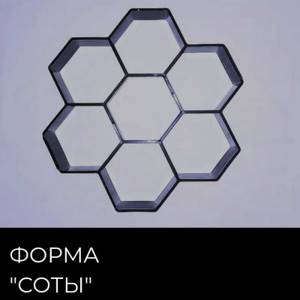
Which material to choose
The materials for tiles are also varied. Each has its own advantages. So, the following common compositions and materials are usually used:
- Sand and cement are temperature resistant, environmentally friendly and safe, recyclable, simple and easy to install.
- Clinker is a safe coating.
- Rubber - for schools, children's hospitals. Slightly springy, not slippery.
- Plastic – does not contain toxins.
- Granite is an expensive material, it looks rich and exclusive.
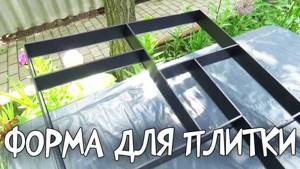
In order to have an idea of the matrix, you can see the photo of the mold for paving slabs.

What qualities are used to choose plastic molds for paving slabs?
Many experts rightfully consider paving slabs to be one of the most competitive concrete products on the market. It is in demand in huge quantities. Even high competition among manufacturers does not prevent the market from increasing its quantitative indicators. Anyone can make a small amount of tiles themselves. This does not require complex equipment or improvised tools. It offers such manufacturers to buy molds for making paving slabs at a low price.
They, like other products of the plant, undergo multifaceted tests in the most difficult conditions of Russian concrete production. Adapted to perform tasks with heavy loads using vibration casting technology:
Plastic molds for paving slabs meet all the qualities listed above. They undergo detailed testing in concrete production. In the process, the forms are adapted to the conditions of strict Russian specifics. Tests are carried out using the technology of vibration casting marble from concrete:
- Mineral fillers such as sand and granite chips are sieved to remove impurities; it is better to use a vibrating sieve for this.
- A plasticizer is added to the traditional components of the concrete mixture at the rate of 100 g per 10 cu. of cement and, if desired, a coloring pigment.
- Forms for pouring paving slabs are laid out on the vibrating platform and the concrete mixture is placed in them.
- It is recommended to do demolding after 18 hours, provided that a plasticizer was used.
Installation of paving slabs can be carried out within six days after production.
By that time, the concrete will have gained the necessary strength to carry out such work. Molds are produced at the enterprise using ABS plastic, which is specially designed for such purposes. Products made from it have qualities demanded by customers:
- Light weight and high strength with ease of use when pouring concrete.
- Ability to withstand up to one hundred production cycles without defects and high maintainability.
- Resistant to abrasive concrete mixtures and aggressive chemical environments.
- Particularly accurate copying of the texture of the master model.
- Sufficient rigidity to allow easy demoulding of the concrete product.
- Environmental cleanliness and safety for human health.
It is recommended to order plastic molds for paving slabs on the Mold Factory website. To do this, you need to go to the catalog and select an item, then place your order using the “cart” button. The company's managers will definitely respond to your call in order to draw up a purchase agreement with you and clarify any remaining questions regarding the acquisition.
Wealth of forms and types
The forms for production are varied. For their manufacture, gypsum, wood, plastic, and iron are often used.

In addition, you can purchase templates at the store or make your own molds.
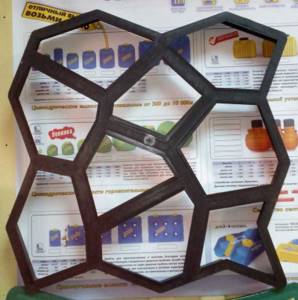
Variety of matrices, their features
Typically, molds for filling are very diverse in configuration, material, number of pattern components, and size.

Whether to make a mold yourself or buy a factory one - this is what is important for the master to understand.
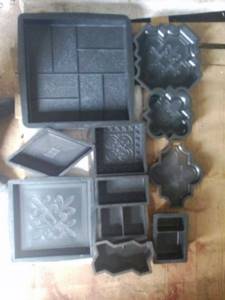
There are the simplest forms, they are usually carved from wood and welded from metal.
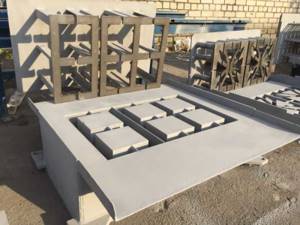
You also need to understand the skills of the craftsman, whether he can operate with forms that are difficult to manufacture.
How to make a matrix yourself
You can learn how to make the form yourself in specialized publications by observing a specialist. It's not very difficult, you need experience, you need to get better at it.
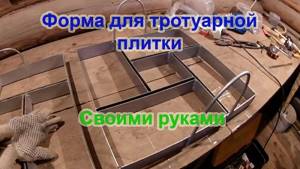
Naturally, you need to study the production technology, find out the specifics and choose what is most suitable.
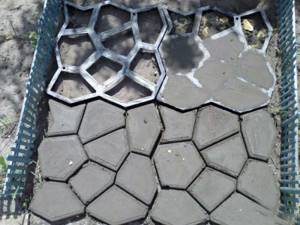
Wood mold
You can take a convenient and familiar tree. This is an elementary version of the form. You will need several planed bars, fastened with metal corners, identical in appearance.
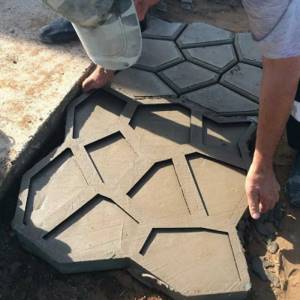
The work takes place in several stages:
- Making identical bars
- Fastening the parts
- Sanding the product

Option No. 1 – metal mold
Metal structures are simple and affordable; their manufacture will require electric welding skills. To obtain a square mold for simultaneous casting of four slabs you will need:
- pallet - a sheet of metal with a thickness of at least 2 mm;
- four corners - the optimal dimensions will be 25*25*3 mm;
- steel handles for easy removal of the mold:
- metal plates - 3 or 4 pieces.
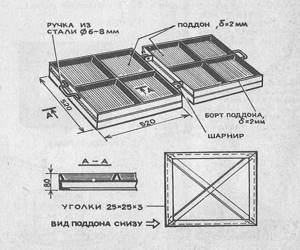
Metal corners are welded to the pallet - these will be the four sides of the mold. The plates are welded together in a cross-shape and welded to the pallet and sides. Handles are attached to the sides. This is the whole simple process of constructing a metal structure for paving slabs. The dimensions of the sides and plates may vary, depending on the selected slab option.
When welding, one point must be taken into account - the top side of the structure should be 1.5 - 2 cm less than the bottom. This will allow you to easily remove the mold from the finished blocks. For this design, it is better to use stainless metal, since during the production of the slabs water will be used - directly in the concrete mixture and for wetting during the hardening stage.
Plastic molds
Such forms are flexible, this is their advantage. Casting is also carried out in plastic molds made of film material, which have fragile walls and require the use of supports.

Acrylic, PVC, ABS, and polystyrene are often used. However, such forms are not durable and must be handled with care. The two-millimeter PVC mold is more durable.
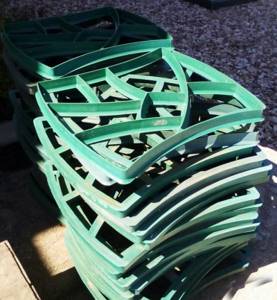
Interestingly, craftsmen have learned to make molds from plastic bottles and any other unnecessary containers. To obtain the shape, cut off the bottom, leaving a part that fits the height of the product.

Option No. 3 – plastic mold
At first glance, it seems difficult to work with molten plastic, however, there will be nothing difficult in creating the structure. You can make various tile shapes from plastic; for this you will need a matrix. For simple rectangular or square tiles, you can use a wooden frame; the outer boards should be three centimeters larger than the inner ones, which will be equal to the size of the finished tile.

DIY plastic mold for paving slabs
The beams are fastened with a screwdriver, and the evenness is checked using a building level. Molten plastic is poured into the finished frame and left to harden. Complete drying will occur in an hour, then the forms can be removed from the frame. Finished products are checked, they must be smooth, all roughness is removed with sandpaper. This completes the process of making plastic molds.
When using them, you should keep in mind that the tiles may stick to the walls of the mold, which will complicate the removal process. To eliminate this, lubricate the inner surface with oil - vegetable or machine oil. Another disadvantage of a plastic mold is that the finished product may have fuzzy, rounded edges.
If you purchase film polyvinyl chloride, the forms will be short-lived, they will last for 50 pouring cycles. Polystyrene is considered the most optimal; it is sold in granules, melts easily, and the products are strong and durable.
DIY molds for paving slabs
Gypsum
You can use a plaster mold.
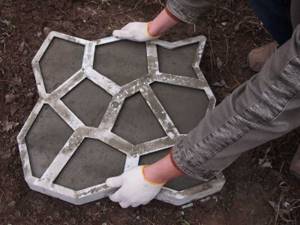
To do this you need:
- Assemble a wooden box 10 centimeters larger in size than the plaster mold
- Pour plaster into it, squeezing out a cast of the desired design
- Be sure to varnish the surface.
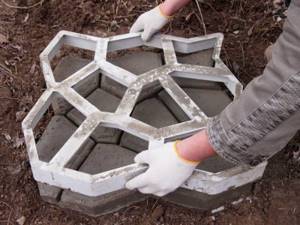
Types of forms

Like all foundry products, molds for paving slabs can also be divided into different classes according to the degree of use.
The forms are divided as follows:
- One-time use for casting decorative or individual elements;
- Semi-permanent (for casting corner elements);
- Permanent (for casting background paving slabs).
As in foundry, the mold is simply a device for creating a working cavity; when filled with a mixture for the production of paving slabs (usually a mixture of cement, gypsum, sand and inorganic pigment), a casting is obtained, which can then be used for paving.
Disposable forms are most often made of plastic; they are quite fragile and can withstand a short period of use. But due to the density of the material, the pattern on the paving slabs turns out to be the clearest of all types of shapes.
Disposable forms also include molds for paving slabs made from household silicone.
Semi-permanent paving molds are made from thermo-polyurethane. It is quite practical and conveys the design of the original print well. Reusable and easy to use. This option of forms is also considered budgetary and today it is the most widely used, especially if the production of paving slabs is organized by yourself.
Permanent forms made of fiberglass and polystyrene have a large margin of safety and are used in industrial applications for the production of paving slabs.
One of the varieties of paving slabs is a garden path; it is made using a joint mold, when the mixture for the production of paving slabs is poured directly onto the ground, and then the joint mold is taken out of it, which visually divides the canvas into separate elements.
Pouring the mixture into the shell of the mold allows you to create an exact copy of the original paving slabs from which a cast was taken for subsequent replicas.
When producing paving slabs using the pressing method, metal molds are used.
| Various colors and finishes | Classic shapes: module, background, trapezoid, with insert |
| Different models depend on the technology and creativity of the manufacturers | Interstitch form |
Matrices made of metal and polymers
The advantage of the metal form is its durability.
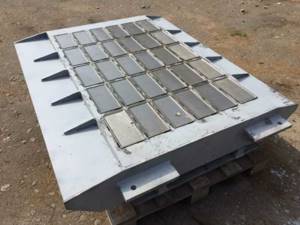
Production of polymer molds:
- Make a wooden box for pouring plastic (with an allowance of 3 cm more than necessary)
- They create another box, this time in size, insert it into a larger one and pour plastic into the hole.
- When using polyurethane, you should remember safety measures and good ventilation of the room.
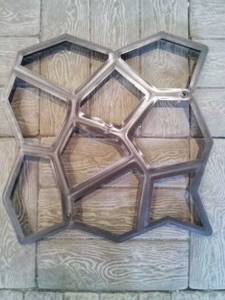
Option No. 4 – silicone mold
Another option for making a mold for paving slabs with your own hands is silicone; you can use it to make any configuration. The technology is simple, first you need to prepare a wooden box, its dimensions can be different, depending on how many forms you plan to place in it.
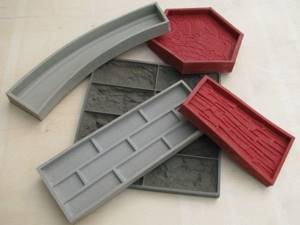
Silicone molds for paving slabs
You can do it yourself by fastening wooden slats with nails or screws. The bottom is made of durable plywood, although it can be made from slats tightly placed next to each other. Next, you will need matrices for the future tiles. The easiest way is to buy several copies of ready-made tiles of the desired size and configuration. The matrices are placed in a wooden box at a distance of at least 5 mm from each other and so that the sides are 5 mm higher than the tiles. The next step is preparing the silicone.
It is necessary to mix the components strictly according to the instructions and strictly observe the temperature regime during heating. Then the mixture is poured into a box with matrices and it needs to be given time to cool, half an hour will be enough. So that the matrices can be easily removed later, they are first generously lubricated with oil.
Silicone molds for paving slabs can be used many times - from 50 to 100, but it is worth noting that the choice of material must be approached carefully, since low-quality raw materials will produce soft structures that are unsuitable for long-term and reusable use.
Silicone forms
Durable and popular material. They are of higher quality, but are also more expensive to manufacture.
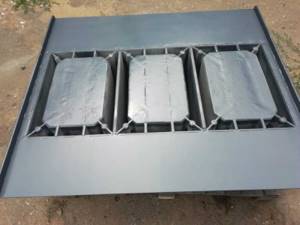
Silicone molds are made according to the general principle: a layer of material is poured in, then removed after initial hardening.
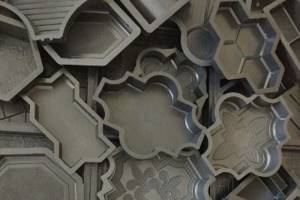
Specifics of working with silicone:
- The plastic hardens quickly, so everything needs to be done clearly and confidently.
- Ideal recognition of parts and accuracy in manufacturing are important
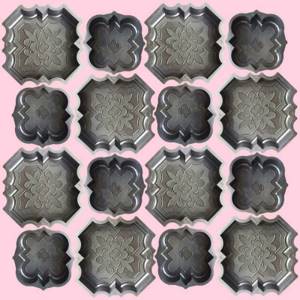
Preparing for pouring
Lubricating the tile molds allows you to remove the product without any problems. Usually the forms of paving slabs are treated with various chemical liquids, for example, varnish, drying oil. There is no need to lubricate plastic, silicone and polyurethane molds.
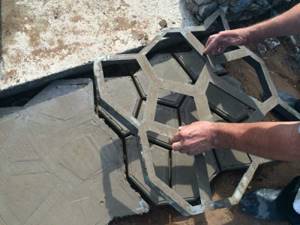
Wax mastic, which craftsmen often use to process molds, is good; the frozen product is better removed. Wooden forms of paving slabs must be lubricated, this is the specificity of the material.
How to make molds with your own hands
Not every design option is easy to manufacture; how to make a form of paving slabs at home - the answer to this question can be found by studying various technologies in more detail. Of the listed materials, only a few types are available for DIY production. For this reason, the simplest options are considered: wood, metal, plastic, plaster and silicone. At the preliminary stage, a drawing of the future structure is drawn up.
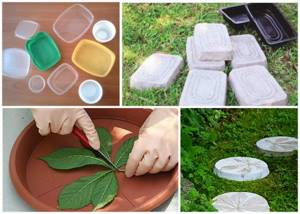
Made of wood
To make the desired shape yourself, prepare small bars. Their size depends on the dimensions of the tile. The structure is assembled quickly, using nails, screws or a tongue-and-groove system. It is important to check that the angles are 90°. Plywood is used as the bottom.
Plastic
Prepare the following materials and tools: container for melting, wooden blocks, fasteners (screws or nails), hammer or screwdriver (depending on which fastening elements are selected). If this method of making a plastic mold is used, you need to prepare the material. The plastic is melted, but this must be done immediately before pouring the wooden formwork. The duration of the period during which the workpiece completely hardens does not exceed 1 hour.
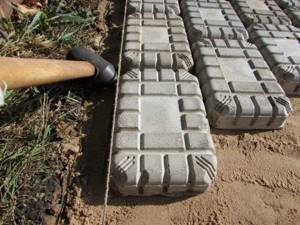
Plaster
In this case, a wooden frame is also used. Homemade tile molds are made using gypsum and water. A plasticizer or cement is added to the mixture. To make the mold, you will need a sample tile. It is treated with a lubricant and immersed in a gypsum mixture, which is first poured into the formwork. The tile is then removed and the finished product is obtained.
Metal
This form is produced relatively quickly. To do this, use a corner or metal strips of the required size (determined by the dimensions of the tile). The parts are connected using bolts, nuts or a welding machine. The seams are cleaned.
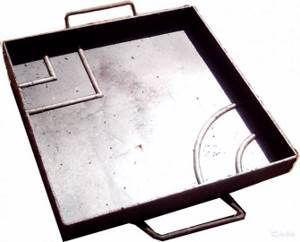
Silicone
To work you will need:
- container for filling silicone;
- sample of a tile covering product;
- construction mixer;
- plasticine to obtain the desired texture;
- three-component silicone.
A sample of the finished product is treated with vegetable oil so that the material does not stick to it. Get the desired silicone consistency using a construction mixer. When the resulting mass is poured into the container, the sample is immersed in its structure. After the silicone hardens, the product is removed.

